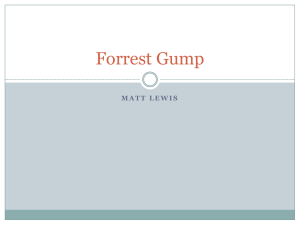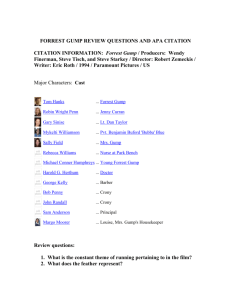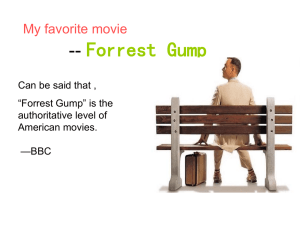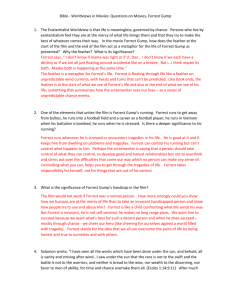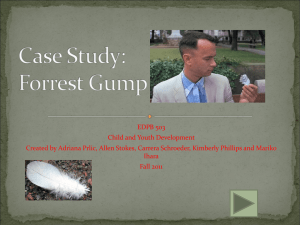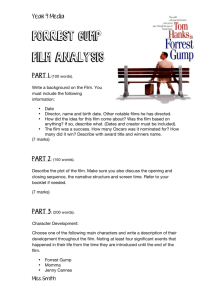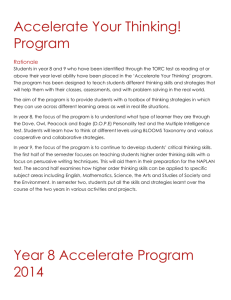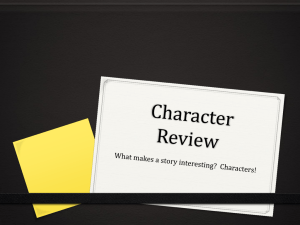Forrest Gump as Equipment for Living for Destiny Seekers Stacy
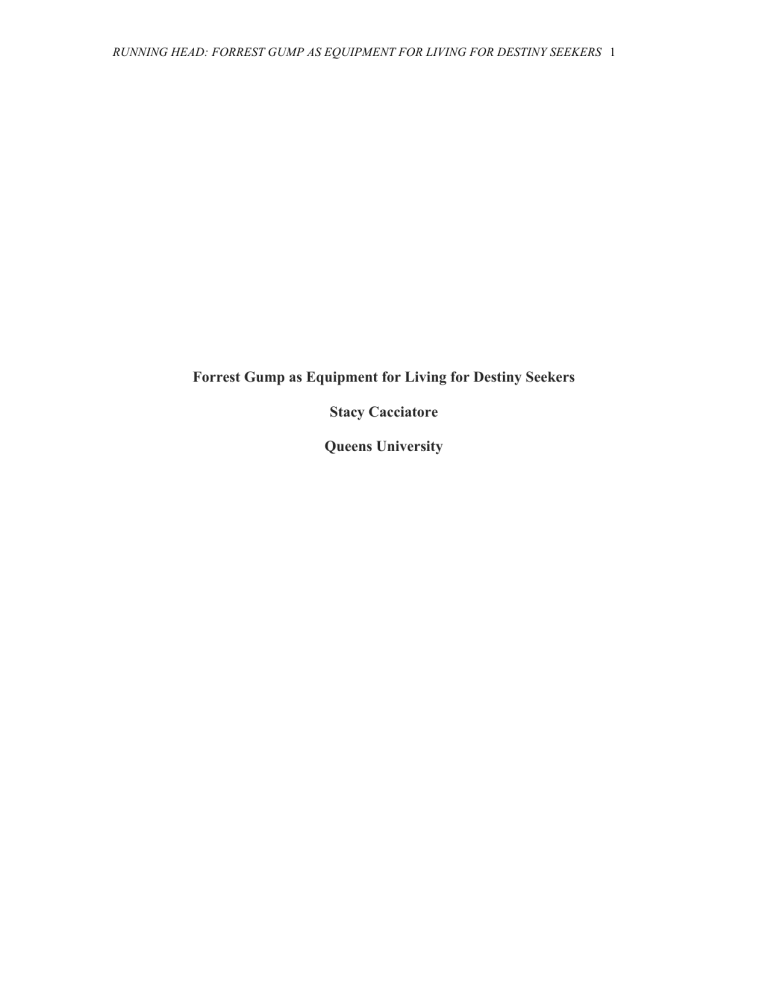
RUNNING HEAD: FORREST GUMP AS EQUIPMENT FOR LIVING FOR DESTINY SEEKERS 1
Forrest Gump as Equipment for Living for Destiny Seekers
Stacy Cacciatore
Queens University
FORREST GUMP AS EQUIPMENT FOR LIVING FOR DESTINY SEEKERS
Forrest Gump (Zemeckis) originated as a novel by Winston Groom (1986) and
2 became a hit movie in 1994, winning six Oscars (Awards). One reason this movie was a box office hit was because the storyline resonated with many viewers. Following 30 years of a young man’s life who achieved success and found his life’s purpose despite his low intelligence quotient (IQ), Forrest witnessed, and even influenced, important events during the ‘50s, ‘60s, ‘70s and ‘80s while experiencing love, loss and joy (Forrest
Gump).
One approach to finding your life’s destiny is to focus on the strengths God has given you. As it says in the Bible, “Each of you received a spiritual gift. God has shown you his grace in giving you different gifts. So be good servants and use your gifts to serve each other” (1 Peter 4:10, New International Version).
To recognize life’s destiny, an individual must understand the gifts God has given. For some, it can be challenging to understand how to recognize the gifts God has bestowed upon them and learn how to use those gifts to achieve their life’s purpose rather than using their shortcomings as an excuse. Forrest Gump (Zemeckis, 1994) provides viewers with the tools they need to achieve their own destiny by providing them with an example of a humble man who doesn’t use his lack of classically defined intelligence or scoliosis as an excuse for achieving success in his life.
This paper will explore how the movie Forrest Gump (Zemeckis, 1994) provides
“equipment for living” (Burke, 1973, p. 304) for those who want to control their own destiny and succeed by pursuing their God-given talents despite the obstacles they face. I will explore how Burke’s equipment for living theory can extend to movies. I will also apply the semiotic communications theory and demonstrate how the signs and symbols in
FORREST GUMP AS EQUIPMENT FOR LIVING FOR DESTINY SEEKERS
Forrest Gump can be interpreted to help others find their own destiny and forage their
3 own path. My research will support three key points: 1) Semiotic tradition can be used to interpret the signs of both the feather and bird as symbols for destiny ; 2) Forrest uses his
God-given talents to succeed in life;3) Forrest embraces the “No excuses” attitude and provides equipment for living for people to pursue their destiny, despite challenges they face.
Literature Review
Kenneth Burke (1984) was an American literary theorist who developed the equipment for living theoretical concept. In his book, Attitudes Toward History, Burke explains “equipment for living” (p. 73) as symbols that are linked to relationships. He suggests that literature serves a rhetorical purpose by helping audiences understand and manage life’s challenges (cited in Littlejohn & Foss, 2011). While Burke focused on how rhetoric in literature provides strategies for responding to life’s challenges, others extend this theory to include movies.
While Burke (1984) focused on the therapeutic process for equipment for living based on literature, scholars have successfully applied Burke’s theory to film, television and virtual media. Both Perks (2007) and Lair (2011) apply the equipment for living theory to television programs and demonstrate the ability for viewers to make connections from the scenarios, both domestic and corporate, to a variety of real-life situations. Lair states that all reality television shows provide equipment for living to viewers because they address situations that individuals are likely to encounter. Young
(2000) focuses his research on movies while Burr-Miller (2011) focuses on the Internet, nevertheless both recognized the symbolic ways audiences connect rhetoric to their own
FORREST GUMP AS EQUIPMENT FOR LIVING FOR DESTINY SEEKERS personal experiences. No matter what the medium, all of the scholars make the same connection: rhetoric can change lives simply by engaging audiences who believe that their situation can change and providing them with the hope that a correction in their
4 course can put them on the right path.
Burke’s equipment for living theory is based on the fact that human’s are selfaware and can make conscious connections between art and real world (cited in
Littlejohn & Foss, 2011). Both Young (2000) and Lair (2011) explore how audiences make connections and interpretations based on rhetoric in movies/television. Lair (2011) found that the interpretive process not only included viewers definitively applying specific examples of how to handle real-world scenarios in the workplace, but also latent inferences. He refers to these inferences as “textual winks,” in which savvy viewers look beyond the surface of the show to understand the deeper meaning of the content (p. 84).
Perks (2007) demonstrates how two reality shows, Supernanny and Dog
Whisperer , both provide equipment for living for viewers who need to create an organized home, as they contain forms of discipline that apply to both subjects. Perks
(2007) found that both pets and children benefit from structured discipline with clear boundary setting. Both also provide tactical solutions for viewers to improve their relationships with their children and/or pets. Perks (2007) and Lair (2011) support
Young’s (2000) argument that audiences make decisions based on film and television.
Burr-Miller (2011) found that fantasy baseball serves as equipment for living by providing baseball fans with symbolic ways to connect baseball to their own personal experience. Burr-Miller (2011) explores rhetoric in a literal and tactical way, providing examples of how fantasy baseball forges relationships and allows players to bridge
FORREST GUMP AS EQUIPMENT FOR LIVING FOR DESTINY SEEKERS fantasy with reality, which is a key component of equipment for living. The researchers
5 tell us that film can provide us with equipment for living in a variety ways, from serving as a metaphor for real-life situations, to engaging our subconscious mind to providing us with a map for navigating similar scenarios.
This paper will focus on the use of semiotic communication tradition. Porcar
(2011) explains, “semiotics appears to be a paradoxical discipline, meaning we find it all around us and, yet, nowhere specifically” (p. 22). Semiotics supplements interpretation by allowing the viewer to evaluate signs, as well as dialogue, setting and text. The goal of semiotics is to explore the relationship, meaning and connections. Semiotics studies how signs come to represent ideas, people and feelings (p. 45). The unifying concept behind semiotics is the sign. Merrell’s (1995) three-dimensional model of triadicity explains the three dimensions of a sign in semiotic tradition. The triadicity model has three areas that are held together with a central axis to illustrate that the interdependencies between the object, representamen and interpretant. Merrell builds on Peirce’s model of triadicity.
Peirce’s model of triadicity follows a “logic of relations”, which Peirce observed as the relationship between any number of entities can be reduced to three (p. 134). Merrell takes Peirce’s model of triadicity one step further by applying it to semiotics and arguing that this cycle is continuous as signs create each other overtime. Merrell states, “It’s definitely a sign’s world. But we are not merely along for the ride.” (p. 134). Morris B.
Holbrook and Mark W. Grayson (1986) support the semiotic communications theory with their evaluation of the film Out of Africa.
They expand upon semiology and evaluate symbolic consumption of art as not just what art tells us about behavior, but on what the consumption tells us about the art.
FORREST GUMP AS EQUIPMENT FOR LIVING FOR DESTINY SEEKERS
While the literature does an excellent job at providing examples of tactical actions, these studies haven’t covered the attitude shift that an individual makes based on interpretation of the literature and/or movie. Compare the difference of using a movie to
6 provide tactical strategies to manage your child’s behavior to evaluating the symbolism in a movie to shift your outlook on life. This paper will demonstrate how the viewer interprets the symbolism in the movie to alter their mindset. I will build upon the researchers conclusions to demonstrate how Forrest Gump (Zemeckis, 1994) provides both definitive and tacit equipment for living for those who want to control their own destiny and succeed despite, or perhaps by virtue of, obstacles they face.
Methodology
I chose the movie Forrest Gump because it personally helped me pursue my destiny in life by embracing the “no excuses” attitude and accepting my God-given talents. This paper uses the semiotic communications tradition to explore the symbolism in the movie. I researched semiotic communications, specifically evaluating Floyd
Merrell’s three-dimensional model of triadicity and how he built upon Peirce’s original model of triadicity. I explored how this model supported the symbolism and “textual winks” used in Forrest Gump to provide equipment for living. I evaluated several articles that conducted an analysis of how literature, movies, TV shows and fantasy baseball provided equipment for living for the viewer. I not only used the research to help draw conclusions about the equipment for living provided in Forrest Gump, but I was also able to identify the gaps in the research to determine where I needed to focus my efforts to draw a conclusion. The details of my literature research are provided in the Literature
Review section of this paper.
FORREST GUMP AS EQUIPMENT FOR LIVING FOR DESTINY SEEKERS
When evaluating the movie Forrest Gump ( Zemeckis, 1994 ), I watched the original film, read components of the original novel (Groom, 1986), read many sections of the script (Roth, 1994), researched the awards the movie had received (Awards),
7 watched specific scenes in detail, read reviews on the International Movie Database, researched facts through the Encyclopedia Britannica, and listened to the sound track by
Alan Silvestri. All of these sources are noted in the Data section of this paper.
To demonstrate how the movie Forest Gump resonated with my own personal experience, I used the example of the recent news story of fitness professional, Maria
Kang. The recent media controversy over Kang’s “No Excuses” photo resonated with me and supplemented the lessons learned in Forrest Gump. I also pulled from my own life experience and blog, Five a Day the Fun Way.
Data
This paper will focus on specific symbolic and narrative scenes Forrest Gump .
Scenes on destiny
In the beginning of the Forrest Gump ( Zemeckis, 1994 ), we see a feather floating through the air in Savannah, Georgia. The feather briefly lands on a man’s shoulder, then gets swept up in the street. The feather bounces off of cars and moves from one object to another before eventually landing on Forrest’s mud-soaked shoe. Forrest picks it up gently and presses it in a Curious George book within his briefcase. The song Forrest
Gump Suite by Alan Silvestri plays in the background.
Destiny is discussed when Forrest and his mother have a conversation about destiny when she’s dying. Mrs. Gump is lying in her bed when Forrest visits her. She
FORREST GUMP AS EQUIPMENT FOR LIVING FOR DESTINY SEEKERS looks into Forrest’s eyes lovingly as she explains to Forrest that death is a part of life.
8
The dialogue of this scene provides us with insight into Mrs. Gump and Forrest’s views on destiny:
Mrs. Gump: I didn’t know it, but I was destined to be your mama. I did the best I could.
Forrest Gump: You did good mama.
Mrs. Gump: Well, I happen to believe you make your own destiny. You have to do the best with what God gave you.
Forrest Gump: “What’s my destiny Mama?”
Mrs. Gump: You’re going to have to figure that out for yourself. Life’s like a box of chocolates, Forrest. You never know what you’re going to get. ( Zemeckis ,
1994)
The final scene in the movie is particularly significant as Forrest addresses the issue of driving forward one’s destiny head-on. Forrest visits Jenny’s grave and speaks to her about their son and how much he still loves her. Tears are in his eyes as he says , "I don't know if we each have a destiny, or if we're all just floating around accidental-like on a breeze, but I think maybe it's both." ( Zemeckis , 1994). Forrest then walks away from her gravesite with a breeze swaying the trees in the air while birds fly overhead. Birds are also significant in the beginning of the movie, as Jenny prays “Dear God, make me a bird so I can fly. Fly far away from here,” ( Zemeckis , 1994) during the scene in which her father is abusing her.
The movie ends with the feather floating through the air again. It picks up the breeze next to Forrest’s foot as he sits on the tree stump by his son’s bus stop. The
FORREST GUMP AS EQUIPMENT FOR LIVING FOR DESTINY SEEKERS 9 feather floats back up to the sky, floating in the breeze as the song Forrest Gump Suite by
Alan Silvestri (1994) plays in the background.
Scene displaying Forrest Gump’s low intelligence quotient
Forrest Gump’s below-average intelligence is made clear to the viewer in the beginning of the movie. Mrs. Gump sits down with the Principal at Forrest’s school and the Principal shows her a chart demonstrating his intelligence compared to other children his age. His chart has “Above”, “Normal” and “Below” written on it with “IQ Scores:
National Average” written on the top. He shows Mrs. Gump that Forrest falls below the
“Average” line and is within the “Below” average intelligence area. He says, “ Your boy's... different, Miz Gump. His IQ's 75” ( Zemeckis , 1994).
While in the military, the Drill Sergeant facetiously asks Forrest Gump and Bubba
Blue, “You twins?” even though it was clear that they weren’t twins. However, both
Forrest and Bubba interpreted the question literally and Forrest responded, “No, we are of not relations Sir” ( Zemeckis , 1994) .
Scenes reinforcing pursuing your God-given talent
Mrs. Gump told Forrest, “You have to do the best with what God gave you.” This is reinforced during the scene with Forrest and his drill sergeant. Forrest and his fellow platoon mates were standing in full-attention in their bunk as their drill sergeant gave orders. Forrest is standing up straight, giving is drill sergeant direct eye contact when his drill sergeant asks:
Drill Sargent: What's your sole purpose in this army?
Forrest: To do whatever you tell me, drill sergeant!
FORREST GUMP AS EQUIPMENT FOR LIVING FOR DESTINY SEEKERS
Drill Sargent: God damn it, Gump! You're a God damn genius! That’s the most
10 outstanding answer I ever heard. You must have a God damn IQ of 160.
( Zemeckis , 1994)
Another example of Forrest achieving success through pursuit of his God-given talent was through running. He discovered had a natural talent for running as a young child when he broke free from his leg braces while running from a class bully. Jenny encouraged him to run as she shouted after him, “Run, Forrest, run!” ( Zemeckis , 1994) .
Forrest learned at that point that he was naturally talented in running, as he said, “From that point on if I was going somewhere, I was running.” ( Zemeckis , 1994) . Forrest is seen running throughout the movie. He ran in college when he joined the football team and acknowledged, “I always ran to get where I was going, I never thought it would take me anywhere,” ( Zemeckis , 1994). Forrest also ran across the country as a young adult, inspiring thousands along the way.
“What’s Your Excuse?” Fitness Photo
I will also tie in the recent news article profiling Maria Kang, fitness aficionado, and her recent “No Excuses” photo. Maria Kang is a 32-year old mom of three who was recently attacked in the media for posting a picture of herself looking buff in a midriff top and short shorts with her three children and the caption “What’s Your Excuse?” (Miller,
2013). This photo launched a hailstorm of controversy after it went viral as many proclaimed that Kang was bullying and “fat-shaming” mothers.
Analysis
There are many life lessons in Forrest Gump that can serve as equipment of living, but the one that resonated with me the most is the theme of finding and pursuing
FORREST GUMP AS EQUIPMENT FOR LIVING FOR DESTINY SEEKERS 11 ones’ destiny without making excuses. I will analyze three key components form Forrest
Gump . First, I will analyze how the feather serves as a symbol for destiny. Secondly, I will explore how Forrest uses his God-given talents to succeed in life. Finally, I will explore how Forrest’s encourages others to pursue their destiny, despite challenges they face, demonstrating how Forrest chooses to embrace the “no excuses” mentality. Forrest
Gump (Zemeckis, 1994) provides viewers with the tools they need to achieve their own destiny by providing them with an example of a humble man who doesn’t use his lack of book-intelligence as an excuse for achieving success in his life.
Semiotics and Destiny
The movie Forrest Gump (Zemeckis, 1994) beautifully combines both the language and signs to paint the picture of a young man fulfilling his destiny. Forrest
Gump both begins and ends with a feather floating through the wind. While the feather may mean many different things to different people, for me, the feather serves as symbolism for the human experience and reaching one’s destiny. This metaphor is reinforced throughout the movie, both through symbolism and rhetoric. The feather serves as a “textual wink” in Forrest Gump as the savvy viewer must look beyond the surface of the dialogue and scenes in the movie to dig deeper and evaluate the symbolism.
Another example of the use of semiotics and textual wink in Forrest Gump is the symbolism of the birds. The savvy viewer must look deeper than the surface to find the meaning behind the use birds in the film. Just as the feather flies throughout the movie, the flight of birds also symbolize destiny in Forrest Gump . Jenny prays for God to turn her into a bird so she can fly far away, as her father was abusing her and she saw no way
FORREST GUMP AS EQUIPMENT FOR LIVING FOR DESTINY SEEKERS out. At the end of the movie when Forrest is by her grave, as he walks away birds fly
12 overhead. This is a textual wink or symbolism that Jenny is now free. She has pursued her destiny and God finally answered her prayer and allowed her to fly away from the pain that she suffered while on earth.
While the feather and bird metaphor serves as a symbol for destiny, the dialogue and script of the movie serve as a rhetorical function that helps the audience understand how they can pursue their own destiny. A key component in the semiotic tradition is how language bridges the world of experience and the human mind. The symbols and dialogue in Forrest Gump send the message that one may fulfill their destiny by embracing the special gifts God has granted you. This is demonstrated through strong semiotic communications tradition, symbolism and dialogue. At the end of the movie Forrest compares destiny with floating around on a breeze, which supports the symbolism of the feather. Additionally, Jenny mentions flying like a bird and we see birds fly over her grave. Notice how the dialogue fits with the semiotics and symbolism of the feather and the bird. All of these components work together seamlessly like a perfect piece of the puzzle, helping the interpreter receive this message.
Speaking of the interpreter, the model of triadicity can also help us understand the semiotics in Forrest Gump . The model of triadicity outlines how signs and symbols are everywhere, but everything can be boiled down to three components: the sign, the interpreter and the transmitter. Throughout the movie relies on the signs, dialogue and our own experiences to help us interpret the symbolism. This points towards the point that Stephen Young (2000) made during his research on equipment for living as it applies to movies. Young said, “The intent is in how viewers consciously interpret the
FORREST GUMP AS EQUIPMENT FOR LIVING FOR DESTINY SEEKERS symbolical potential of the film and how they use these interpretations to negotiate the
13 struggles of everyday life” (p. 449).
In Forrest Gump , the feather serves as the sign, while Forrest is transmitter and the viewer is the interpreter. Using this model of triadicity, we can see that it is up to us, as the interpreter, to apply what the feather symbolizes in our own life. For me, t he feather reinforces what Forrest says about destiny, when he says , "I don't know if we each have a destiny, or if we're all just floating around accidental-like on a breeze, but, I think maybe it's both." ( Zemeckis , 1994). During this moment Forrest is addressing a founding principle of destiny. Do we have a sole purpose in life or do we just happen onto circumstances?
On one side of the equation, it can be said that Forrest doesn’t purposefully pursue his destiny, but rather he accidentally falls into a variety of circumstances. One may also point out that everything he achieved, from breaking the Watergate scandal to achieving success as a shrimp boat captain to having a child, was accidental. One may even say that none of his achievements were a result of him pursuing his destiny, but instead his ignorance alone inhibited him from feeling fear. However, I believe that his achievements weren’t accidental, but rather were a result of Forrest actively pursuing his
God-given talent.
Pursuing one’s destiny by embracing your God-given talent
The fact that Forrest isn’t classically “smart” serves as a key point in the theory of achieving your destiny through pursuing your God-given talents. While Forrest was viewed as an “idiot” by his teachers, friends and peers, he achieved great success in his life due to his mother supporting him in finding his God-given talents. When his mother
FORREST GUMP AS EQUIPMENT FOR LIVING FOR DESTINY SEEKERS was dying she told Forrest that it was her destiny to be his mother. Forrest asked about
14 his own destiny and she told him that it was for him to discover. Without her knowing it, she did help him discover his destiny throughout his life by helping him understand he could achieve anything despite his low IQ.
One example of Forrest achieving success through pursuit of his God-given talent was through running. He discovered he had a natural talent for running as a young child and he used his God-given talent to help him succeed. As Forrest said, “I always ran to get where I was going, I never thought it would take me anywhere,” ( Zemeckis , 1994).
But running did take him somewhere. Running enabled Forrest to receive a scholarship and go to college. After he graduated from college, he joined the Army, where he found a perfect fit.
He was a genius in the eyes of the drill sergeant because he was able to play to his strengths and God-given talent to achieve success. From loading his weapon quicker than his platoon mates, to following the drill sergeant’s orders, to saving Captain Dan’s life, to receiving the Medal of Honor, Forrest was a huge success in the military despite his lack of intelligence. Again, his God-given talent provided him with the tools to be successful in this role. Forrest excelled in the Army, he was a world-renowned Ping-Pong champion, he ran clear across the United States and he was a successful shrimp boat captain. He achieved a lot of success in life, achieving financial wealth, love and family. However, his destiny could have played out much differently if he used his lack of book-smarts as an excuse, proving the point that you have to do the best with what God gave you.
No Excuses
FORREST GUMP AS EQUIPMENT FOR LIVING FOR DESTINY SEEKERS
What if Forrest would have turned down playing football because thought it would take too much effort? What if he never tried to run because of his leg braces and scoliosis? What if he decided not to go to college because he didn’t think he was smart
15 enough? What if Forrest would have turned down the request to join the Army because he was too fearful to leave home? Forrest accepted the challenges that life brought before him and he never let his intelligence get in the way of achieving his goals. It would have been easy for Forrest to let his low IQ serve as an excuse, but he never did. A great example of how I used this in my own life is by embracing the phrase, “No excuses.” As
I mentioned in my Data section, recently a mother and fitness aficionado, Maria Kang was attacked in the media for posting an image of herself looking buff in a mid-riff top and shorts with her three children and the caption “No excuses” (Miller, 2013). She was accused of “fat-shaming” and bullying women about their bodies. However, those who are attacking Kang don’t know or understand her journey. Kang stated that she suffered from eating disorders for years and has struggled with her body image since she was a child. This resonated with me, as I also was a chubby child, anorexic teenager and obese adult. I have struggled with my weight, body image and eating disorders my entire life. I started a blog, Five a Day the Fun Way, to help me overcome my eating disorder and find a fun, relaxed way to embrace a healthy lifestyle. On my blog I have the tagline, “I have struggled with my weight and eating disorders for my entire life. I was an overweight child, an anorexic teen and an obese adult” (Cacciatore, 2013).
Just six years ago I was overweight, smoked a pack of cigarettes a day and couldn’t walk up a flight of stairs without getting winded. When I hit an all-time high of
220 pounds, 30 percent body fat and size 22 jeans, I knew that something had to change. I
FORREST GUMP AS EQUIPMENT FOR LIVING FOR DESTINY SEEKERS completely immersed myself in education about health, nutrition, wellness and fitness
16 and quit smoking, lost 80 pounds, 11 sizes and over half my body fat through diet and exercise. Since then I’ve run three marathons, seven triathlons and 15 half marathons.
I’ve won medals in five events, placing in my age category. I work hard each and every day and I embrace the model, “no excuses”. Just as Forrest didn’t let his low intelligence or leg braces serve as an excuse, I don’t let my slow metabolism, genetic disposition to gain weight or lack of inherent athleticism serve as an excuse. Forrest showed me that hard work, determination and a “no excuses” attitude will help me pursue my destiny.
Forrest didn’t let his lack of intelligence or scoliosis hold him back.
For me this has served as what Payne (1989) would call “therapeutic rhetoric” meaning that I used the film Forrest Gump to work through my own self-perceived weaknesses. There are times when I’m tempted to use an excuse, but then I’m inspired when I think of Forrest and the obstacles he had to overcome. Forrest had a belowaverage intelligence, he wasn’t wealthy and he wore leg braces as a child because of his scoliosis. However, he never let any of those obstacles get in his way of achieving success.
During the conversation between Forrest and his mother, Mrs. Gump states that she believes in creating your own destiny. I believe in this as well. Forrest Gump served as equipment for living for me as I define my path in life and try to understand my destiny. I don’t believe that we fall victim to life’s circumstances, but we need to take charge and create our own path in spite of challenges we may experience.
Conclusion
FORREST GUMP AS EQUIPMENT FOR LIVING FOR DESTINY SEEKERS 17
The movie Forrest Gump offers equipment for living for those who desire to find their life’s destiny. When reflecting back on what I learned from Forrest Gump , I think of the quote from Walt Disney, “All of our dreams can come true, if we have the courage to pursue them” (Disney Book Group, 2001). That quote summarizes my viewpoint on destiny. I believe we have full control over our destiny. Forrest had a dream and vision for what he wanted to achieve. Not only did Forrest have a dream, but he took action and steps to achieve his dream. It’s one thing to have a dream for what one wants to achieve, but without a plan, it’s just a dream. One must have a plan and take action against their goals in order to achieve them. Forrest also demonstrated that one must believe that success is possible to achieve it. Forrest didn’t use his challenges as excuses, instead he took advantage of his God-given gifts. I have applied Forrest’s lessons in my own life. I focus on my strengths, not my weaknesses. I have big dreams for myself in what I want to achieve, but I don’t simply have a dream, I build a plan of action for what I want to achieve. Forrest helped me realize that I don’t have to be the most intelligent or wealthy to achieve success in life, I just have to have the courage to pursue my dreams.
Additionally, Forrest taught me not to use obstacles as excuses in life.
Through the application of semiotic theory, we can look beyond the surface of the movie and understand the deeper meaning and symbolism. Forrest drives a clear path allowing for us to follow in his footsteps and take charge of our destiny. Through discovering our natural God-given talents and embracing a “no excuses” attitude, we can achieve our life’s destiny.
FORREST GUMP AS EQUIPMENT FOR LIVING FOR DESTINY SEEKERS 18
FORREST GUMP AS EQUIPMENT FOR LIVING FOR DESTINY SEEKERS
Works Cited
Awards (n.d.). In International Movie Database online. Retrieved from
19 http://www.imdb.com/title/tt0109830/awards
Burke, K. (1984). Attitudes toward history . Berkeley, CA: U. of California Press.
Burr-Miller, A. (2011). What’s Your Fantasy? Fantasy Baseball as Equipment for Living.
Southern Communication Journal, 76 (5) 443-464.
Cacciatore, S. (2013). Five a Day the Fun Way. Retrieved from http://fiveadaythefunway.com/about-me/.
Disney Book Group (2001). Quotable Walt Disney.
New York: Disney Editions.
Finerman, W., Tisch, S., Starkey, S. and Newirth, C. (Producers) & Zemeckis, R.
(Director). (July 6, 1994) Forrest Gump.
United States: Paramount Pictures.
Forrest Gump (n.d.). In Encyclopedia Britannica online. Retrieved from http://www.britannica.com/EBchecked/topic/690378/Forrest-‐Gump
Forrest Gump. (n.d.). In International Movie Database (IMDB). Retrieved from http://www.imdb.com/title/tt0109830/
Forrest Gump (n.d.). In Wikipedia. Retrieved from http://en.wikipedia.org/wiki/Forrest_Gump on September 30, 2013.
Groom, W. (1986). Forrest Gump . New York: Vintage Books.
Holbrook, M. and Grayson, M. (1986) The Semiology of Cinematic Consumption:
Symbolic Consumer Behavior in Out of Africa. Journal of Consumer Research ,
13( 3 ), 374-381.
FORREST GUMP AS EQUIPMENT FOR LIVING FOR DESTINY SEEKERS 20
Lair, D. (2011). Surviving the Corporate Jungle: The Apprentice as Equipment for Living in the Contemporary Work World. Western Journal of Communication , 75 (1), 75-
94. Doi: 10.1080/10570314.2010.536966
Littlejohn, S. W. and Foss, K. A. (2011). Theories of Human Communication . Long
Grove, Illinois: Waveland Press, Inc.
Merrell, F. (1995). Semiotics in the post modern age . Lafayette: IN: Purdue Research
Foundation.
Miller, T. (2013). Moms of 3 called bully for posting ‘What’s Your Excuse?’ fitness photo” New York Daily News. Retrieved from http://www.nydailynews.com/lifestyle/health/mom-3-called-bully-excuse-fitness-photo-article-1.1487278
Nuessel, F. (2012). The semiotics of communication. Semiotica , 2012(189), 271-285.
DOI: 10.1515/sem-2012-0035
Perks, L. (2007). Equipment for Living in an Ordered Home: Disciplinary Homologies in
Supernanny and Dog Whisperer . Conference papers-- National Communication
Association . 1-20.
Porcar, C. (2011). Sign and Meaning: A Semiotic Approach to Communication. Journal for Communication & Culture, (1) , 20-29.
Roth, E. (1994). Forrest Gump . [Film Script]. Retrieved from http://www.imsdb.com/scripts/Forrest-Gump.html
Silvestri, A. (1994). Forrest Gump Suite. On Forrest Gump The Soundtrack [CD] New
York: Paramount Pictures Records/Epic.
FORREST GUMP AS EQUIPMENT FOR LIVING FOR DESTINY SEEKERS
Tit for tat [Television series episode]. (2004, February 12). In M. Burnett & D. Trump
21
(Executive Producers) The Apprentice . New York: NBC. Retrieved from
YouTube https://www.youtube.com/watch?v=iT8h8rxZpk0.
Young, S. (2000). Movies as Equipment for Living: A Developmental Analysis of the
Importance of Film in Everyday Life. Critical Studies in Media Communication ,
17(4), 447-468.
